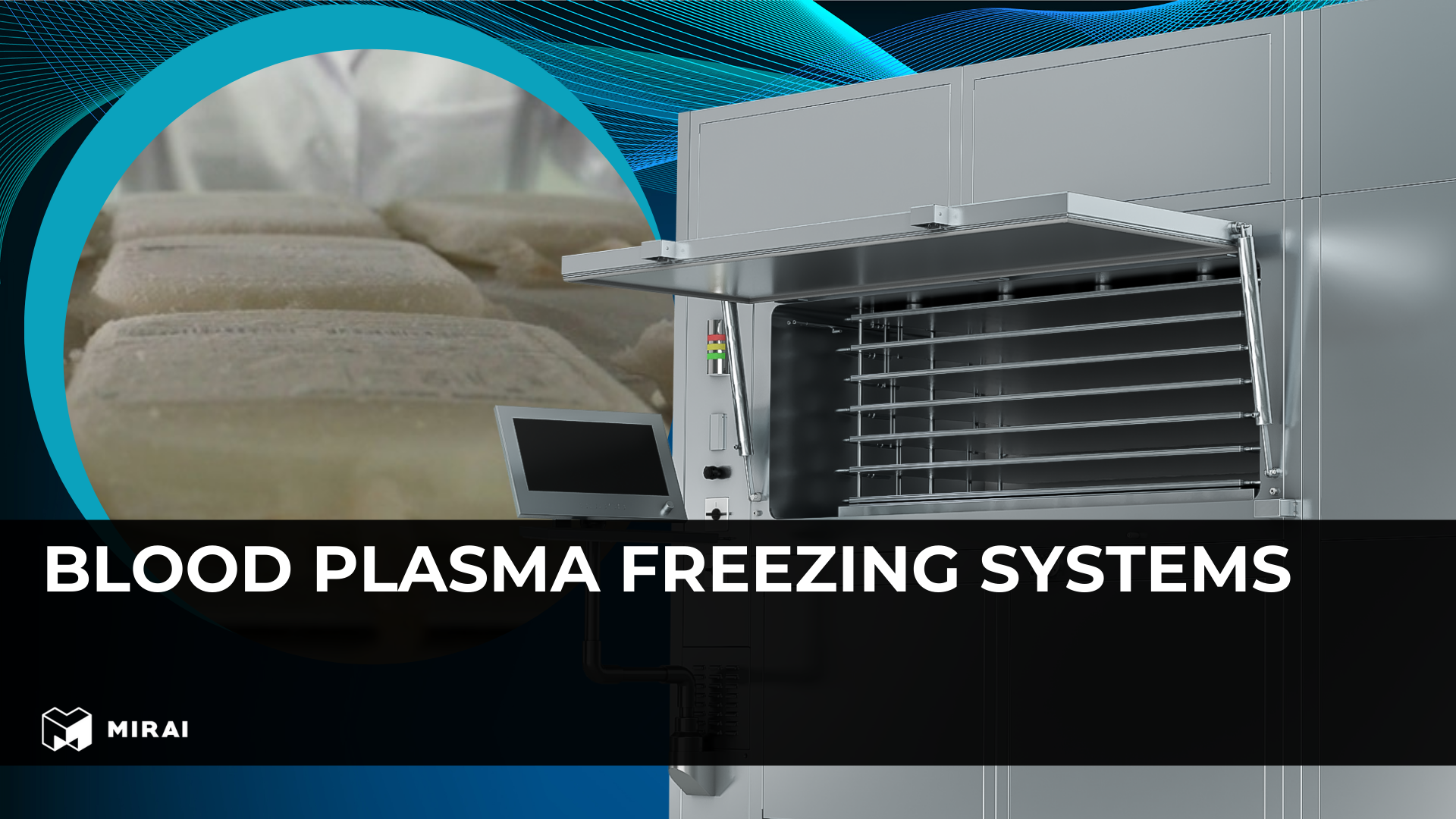Blood Plasma Freezing Systems

Blood Plasma Freezing Systems are sophisticated devices that freeze and store plasma in a controlled process to preserve its biochemical integrity. These systems are used in blood banks, hospitals, laboratories, and medical centers where plasma storage is crucial for transfusions and therapeutic applications. Proper temperature control ensures the preservation of essential proteins, coagulation factors, and other vital components.
Plasma, the liquid component of blood, is an essential biological material used in a wide range of medical treatments. It contains vital proteins such as albumin, fibrinogen, immunoglobulins, and clotting factors that play a critical role in managing bleeding disorders, immune deficiencies, and other life-threatening conditions. Since plasma is highly perishable, specialized freezing systems are required to rapidly lower its temperature, ensuring long-term viability and efficacy.
The Importance of Proper Plasma Storage for Medical Use
Plasma, the liquid portion of blood, plays a key role in various medical treatments, including transfusions, research, and therapies. Proper storage is essential to maintain its effectiveness, as it contains critical elements like clotting factors, cryoprecipitate, and proteins used in medical applications. Improper storage can degrade plasma, making it ineffective or even harmful to patients. Plasma freezers and blood bank freezers are specially designed to meet stringent temperature stability and long-term storage requirements.
Key Requirements for the Freezing Process
To ensure optimal plasma preservation, blood plasma freezing systems must meet the following standards:
- Temperature Control: Plasma should be frozen below -30°C, with optimal storage between -40°C and -80°C.
- Rapid Freezing: Quick freezing prevents ice crystal formation, minimizing damage to plasma proteins.
- Uniform Freezing: Consistent freezing conditions help maintain plasma’s biochemical properties.
- Regulatory Compliance: Plasma freezers must adhere to strict health and safety standards.
- Reliable Monitoring: Advanced monitoring systems track temperature fluctuations for optimal storage.
The Role of Temperature in Preserving Proteins and Coagulation Factors
Temperature plays a crucial role in plasma storage, as proteins and coagulation factors are highly sensitive to heat variations. Exposure to temperatures outside the recommended range can degrade key proteins like fibrinogen and albumin, reducing plasma’s medical effectiveness. Cryoprecipitate, a fraction of plasma rich in clotting factors, requires strict temperature maintenance to remain viable for transfusions and treatments. Research in polyscience and medical sciences highlights that proper freezing prevents protein denaturation and preserves plasma's functional integrity.
Optimal Freezing and Storage Conditions
To ensure plasma components remain intact, the following conditions should be met:
- Freezing Temperature: -40°C or lower
- Storage Temperature: -40°C to -80°C
- Humidity Control: Minimal moisture exposure to prevent contamination
- Storage Duration: Up to one year if properly frozen
Types of Blood Plasma Freezing Systems
Different plasma freezing systems are available, each catering to specific medical and reliability research needs:
- Fast Freezing: Rapidly cools plasma to prevent large ice crystal formation, commonly used in blood transfusion centers and research labs.
- Slow Freezing: A gradual cooling process used for specific medical and research applications requiring controlled ice formation.
- Contact-Cooled Units: Plasma bags come into direct contact with a cooling surface, ensuring efficient and uniform freezing, often used in blood banks.
- Air Freezers: Use cold air circulation for freezing, providing uniform cooling but at a slower rate than contact-cooled units. Ideal for facilities requiring scalable storage solutions.
Innovative Blood Plasma Freezers HOF FTU Blood Plasma Freezer
The HOF FTU Blood Plasma Freezer is a groundbreaking advancement in controlled freezing and thawing of blood plasma and biopharmaceutical products. Developed through a collaboration between Refolution GmbH and HOF Sonderanlagenbau GmbH, this cutting-edge system is elevated by MIRAI INTEX’s state-of-the-art ultra-low temperature cooling technology, ensuring unparalleled efficiency, safety, and reliability .
As the need for superior plasma preservation continues to rise, this innovation sets a new standard in eco-friendly cryogenic freezing. Leveraging air as a natural refrigerant (R729), it eliminates harmful greenhouse gases while delivering exceptional temperature stability, making it the most reliable and sustainable plasma freezing solution available.
The HOF FTU Blood Plasma Freezer, in combination with MIRAI INTEX’s cutting-edge cooling technology, represents the next evolution in plasma freezing systems. These high-precision freezers integrate advanced cryogenic cooling techniques, setting new industry standards.
Key Features of Refolution & MIRAI Plasma Freezers
- Ultra-Low Temperature Cooling: Maintains temperatures as low as -80°C with precision.
- Energy Efficiency: Uses MIRAI INTEX’s innovative cooling system to reduce energy consumption.
- Smart Temperature Control: Advanced monitoring and real-time data logging ensure compliance with health regulations.
- Rapid Freezing Capability: Reduces ice crystal formation to preserve plasma integrity.
- Sustainable Cooling Solutions: Utilizes environmentally friendly cooling agents to minimize environmental impact.
MIRAI INTEX has transformed plasma freezing by introducing next-level cooling technology that surpasses traditional methods, ensuring greater efficiency and reliability.
Why Choose the HOF FTU Blood Plasma Freezer?
✅ Regulatory Compliance: Fully adheres to FDA, WHO, and EU safety standards.
✅ Eco-Friendly: Uses R729 air refrigerant, completely eliminating harmful F-gases.
✅ Precision Freezing: Ensures uniform, ultra-low temperature storage to protect plasma quality with accuracy 0.5 K.
✅ Scalable & Efficient: High-capacity freezing plates and rapid processing make it ideal for blood banks, hospitals, and research facilities.
✅ Compatible with any adjustments: Air is a completely free and safe refrigerant with no toxicity and permanent approval, ensuring a long-term and secure investment for the customer.
Through innovation, reliability , and high-performance freezing, MIRAI INTEX continues to revolutionize cryogenic storage solutions, ensuring safer, more efficient, and environmentally responsible plasma preservation for the future of healthcare and biopharmaceutical research.
To learn more watch the video from HOF Sonderanlagenbau GmbH:
Applications of Frozen Plasma
Frozen plasma is widely used in various medical and research fields, including:
- Transfusion Medicine: Treats coagulation disorders, severe bleeding, and plasma exchange therapy.
- Pharmaceutical Research: Used in vaccine production, therapeutic protein development, and other medical advancements.
- Biomedical Sciences: Essential for studying blood disorders, immune system responses, and new treatment methods.
- Regenerative Medicine: Plasma-derived components aid in developing new cell-based therapies.
- Emergency Medicine: Used in trauma care and critical surgeries to manage excessive bleeding.
Regulatory Standards for Plasma Freezers
Blood plasma freezing systems must comply with stringent health and safety regulations to ensure patient safety. Key regulatory bodies and standards include:
- FDA (Food and Drug Administration): Oversees plasma storage and handling in the U.S.
- AABB (Association for the Advancement of Blood & Biotherapies): Sets best practices for blood banks.
- WHO (World Health Organization): Establishes global plasma safety recommendations.
- ISO 13485: Ensures plasma freezer manufacturers meet medical device quality standards.
- European Medicines Agency (EMA): Regulates plasma handling and therapeutic applications in Europe.
Latest Developments in Plasma Freezing Technology
Advancements in blood plasma freezing systems continue to enhance efficiency and effectiveness. Recent innovations include:
- Automated Plasma Freezers: AI-driven systems for precise temperature control and real-time monitoring.
- Eco-Friendly Freezing Systems: New models that reduce energy consumption while maintaining optimal freezing conditions.
- Smart Monitoring Systems: Integration of IoT and cloud-based tracking for remote temperature regulation.
- Advanced Cryopreservation Techniques: Research on glycerol-based cryoprotectants to further prevent plasma degradation.
- MIRAI INTEX’s Innovations: Revolutionary cooling technology shaping the future of plasma storage.
Conclusion
Blood Plasma Freezing Systems play a crucial role in preserving plasma for medical and research applications. With cutting-edge solutions like MIRAI INTEX’s advanced cooling technologies, the industry is experiencing significant advancements in plasma storage. These state-of-the-art systems ensure efficiency, reliability , and compliance with the highest medical standards, making them an invaluable asset in modern healthcare and research.
As the demand for high-quality plasma continues to grow, innovations in freezing technology are revolutionizing the way medical facilities, blood banks, and research institutions store and manage plasma. The integration of automated monitoring, eco-friendly cooling solutions, and AI-driven freezing protocols has improved the reliability and safety of plasma storage. These advancements not only extend plasma’s shelf life but also enhance its therapeutic effectiveness, ensuring that critical medical treatments remain available for patients in need.
Looking ahead, the future of plasma freezing systems lies in further advancements in cryopreservation, real-time data tracking, and energy-efficient storage solutions. The medical industry is moving toward more sustainable and precise freezing methods, reducing waste and optimizing resources. With continued research and development, next-generation plasma freezing technologies will provide even greater accuracy, efficiency, and global accessibility, ultimately improving patient outcomes and advancing scientific discoveries in transfusion medicine and biopharmaceutical research.


